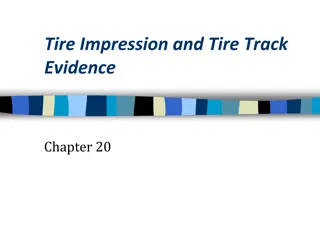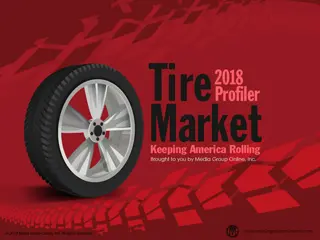Feasibility Assessment of Reclaimed Fly Ash and Ground Tire Rubber Modified Concrete
Feasibility study on incorporating reclaimed fly ash (RFA) and ground tire rubber (GTR) into concrete to address the shortage of fly ash. Investigation of fresh, mechanical, and durability properties of GTR-modified concrete containing FFA and RFA. Focus on reducing carbon footprint, enhancing durability, and minimizing waste tire management issues.
- Feasibility study
- Concrete modification
- Reclaimed fly ash
- Ground tire rubber
- Sustainable construction
Download Presentation

Please find below an Image/Link to download the presentation.
The content on the website is provided AS IS for your information and personal use only. It may not be sold, licensed, or shared on other websites without obtaining consent from the author. Download presentation by click this link. If you encounter any issues during the download, it is possible that the publisher has removed the file from their server.
E N D
Presentation Transcript
TRRGP 2021 - Feasibility Assessment of Reclaimed Fly Ash (RFA) and Ground Tire Rubber (GTR) Modified Concrete PI: Dr. Zahid Hossain, Professor of Civil Engineering GRA: Abu Sayed Mohammad Akid, Graduate Student Arkansas State University 1
Rapid development Most widely utilized Increase in demand CO2 emissions Incorporation of SCMs in concrete: => Reduce carbon footprint Incorporating SCMs Commonly used SCM => Enhance durability performance => Reduce cement consumption cost o Changing fuel sources in some power plants => decline in fly ash availability Therefore, it is crucial to find alternative SCM to address the likely shortage of fly ash. 2
An ever-growing issue for solid waste management authorities in Arkansas Generation of millions of waste automobile tires Using waste tires as fuel generates toxic gases Dumping them in landfills not sustainable Crucial to minimize the issues of managing and disposing of waste tires Incorporating waste tire rubber into concrete as construction material Concrete Ongoing study aims to investigate fresh, mechanical, and durability properties of concrete incorporating Class F fly ash (FFA) and reclaimed fly ash (RFA), and waste ground tire rubber (GTR) as a replacement for sand and cement. 3
Investigate fresh and mechanical properties of GTR-modified concrete containing FFA and RFA. Evaluate the long-term durability of GTR-modified concrete containing FFA and RFA. Determine optimum dosage of GTR in concrete in terms of overall performance. 4
Table: Concrete ingredients Materials Type Coarse aggregate Crushed limestone Fine aggregate Concrete sand Ground tire rubber (GTR) #40-80 mesh particles Binder ASTM C150 Type I/II Portland cement (PC) Supplementary cementitious materials (SCMs) Class F fly ash (FFA) Reclaimed fly ash (RFA) Micronized rubber powder (MRP) #200 mesh particles Chemical admixture o Air-entraining admixture (Daravair 1400) o Water reducer (ADVA 140M) Water Fresh potable tap water Table: Chemical compositions of cement and SCMs Material PC FFA RFA CaO 64.80 8.42 1.85 SiO2 19.80 57.19 53.39 Al2O3 4.70 20.21 28.01 Fe2O3 3.80 10.18 7.72 SO3 3.38 1.18 0.09 MgO 2.20 1.58 1.00 K2O 0.54 2.68 2.24 Na2O 0.16 1.15 0.33 5
Coarse aggregate CA lower limit FA lower limit Fine aggregate CA upper limit FA upper limit Table: Physical properties of aggregates 120 Properties Limestone 0.20 100.5 1-1/2 1 - 2.76 2.78 2.82 0.80 Sand 0.16 - - - 2.56 2.61 2.63 2.67 0.88 100 Moisture content (%) Unit weight (lb/ft3) Maximum size (inch) Nominal maximum size (inch) Fineness modulus Bulk specific gravity (dry) Bulk specific gravity (SSD) Apparent specific gravity Absorption (%) Percent finer (%) 80 60 40 20 0 0.1 1 Sieve size (mm) 10 100 Figure: Gradation curve of coarse and fine aggregate (a) (f) (b) (c) (d) (e) Figure: (a) Quartering of limestone (b-c) moisture content of limestone and sand (d) unit weight of limestone (e) sieve analysis of sand and (f) specific gravity of sand 6
Table: Properties of ground tire rubber (GTR) Properties Minimum Acetone extractables 6.0% Ash content Carbon black 26.0% Natural rubber 10.0% Rubber hydrocarbon 42.00% Moisture content Fiber content Metal content Bulk density 22 lb./ft3 Specific gravity 1.10 Maximum 22.0% 8.0% 38.0% 35.0% - 1.0% 0.01% 0.10% 28 lb./ft3 1.15 Test method TGA TGA TGA TGA TGA ASTM D5603 ASTM D5603 ASTM D5603 ASTM D5603 Typical - - - - 7
Table: Concrete mixture proportions Remarks Control RFA based Mix no. 1 2 3 4 5 6 7 8 9 10 11 12 13 14 Note: GTR = Mesh #40-80 particles and MRP = Mesh #200 passing particles Mixture ID F20 R20 F20-S95-G5 F20-S90-G10 F20-S85-G15 R20-S95-G5 R20-S90-G10 R20-S85-G15 F16-P4 F13-P7 F10-P10 R16-P4 R13-P7 R10-P10 Cement (%) FFA (%) 80 80 80 80 80 80 80 80 80 80 80 80 80 80 RFA (%) - 20 - - - 20 20 20 - - - 16 13 10 GTR (%) - - 5 10 15 5 10 15 - - - - - - MRP (%) - - - - - - - - 4 7 10 4 7 10 Sand (%) 100 100 95 90 85 95 90 85 100 100 100 100 100 100 20 - 20 20 20 - - - 16 13 10 - - - GTR as sand replacement (FFA mixes) GTR as sand replacement (RFA mixes) MRP as filler (FFA mixes) MRP as filler (RFA mixes) 8
Table: Test descriptions Properties Test name Specimen size Testing age Test standard Fresh properties Slump (workability) Temperature Unit weight Air content** 100 x 200 x 300 mm - 0.25 cft 0.25 cft Immediately ASTM C143 ASTM C1064 ASTM C138 ASTM C231 Mechanical properties Compressive strength Splitting tensile strength Flexural strength Modulus of elasticity 100 x 200 mm 100 x 200 mm 100 x 200 mm 150 x 300 mm 7, 28 and 90 days 28 days 28 days 28 days ASTM C39 ASTM C496 ASTM C78 ASTM C469 Durability properties Drying shrinkage 75 x 75 x 250 mm 4, 7, 14, 28, 56, 90, 112 and 224 days ASTM C157 Alkali-silica reaction (ASR) 25 x 25 x 250 mm 4, 8, 12, 14, 16, 20, 24 and 28 days ASTM C1567 Sulfate attack 25 x 25 x 250 mm 1, 2, 3, 4, 8, 13 and 15 weeks ASTM C1012 Surface scaling resistance 75 x 75 x 250 mm 15 cycles ASTM C672 **Using the pressure meter and super air meter (SAM) 9
(c) (d) (e) (f) (g) (b) (a) (h) (k) (i) (l) (j) (m) Figure: (a) slump (b) temperature (c) unit weight (d-e) air content by pressure meter and SAM (f) compressive strength (g) splitting tensile strength (h) flexural strength (i) modulus of elasticity (j) ASR: curing specimen in NaOH Solution at 80 C (k) drying shrinkage: air curing (l) sulfate attack: taking reading (m) scaling: specimen submerged in CaCl2 solution 10
Reduction in slump = GTR- modified concrete Rough surface of the tire rubber particles in the mixture 4 Slump (inches) 3 2 1 Mixture ID Figure: Slump test results of concrete mixtures 11
Table: Temperature of concrete mixtures Mixture ID F20 F20-S95-G5 F20-S90-G10 F20-S85-G15 F16-P4 F13-P7 F10-P10 Temperature ( F) 74 79 76 76 77 78 76 Mixture ID R20 R20-S95-G5 R20-S90-G10 R20-S85-G15 R16-P4 R13-P7 R10-P10 Temperature ( F) 74 77 71 76 76 76 76 12
150 Reduction in unit weight = GTR- modified concrete The low specific gravity of the tire rubber particles compared to sand 146 Unit weight (lb/ft3) 142 138 134 130 Mixture ID Figure: Unit weight of concrete mixtures 13
8 Increase in air content = GTR- modified concrete The nonpolar nature of tire rubber particles and their tendency to repel water and entrap air in concrete 7 Air content (%) 6 5 4 3 2 Mixture ID Figure: Air content of concrete mixtures 14
6000 Decrease in compressive strength = GTR- modified concrete The weak bond between the tire rubber particles and cement paste in concrete 7 days 28 days 90 days Compressive strength (psi) 5000 4000 3000 2000 1000 0 Mixture ID Figure: Compressive strength of concrete mixtures 15
500 Reduction in tensile strength = GTR- modified concrete The weak bonding at the interfacial transition zone (ITZ) Tensile strength (psi) 400 300 200 100 0 Mixture ID Figure: Splitting tensile strength of concrete mixtures at 28 days 16
600 Reduction in flexural strength = GTR- modified concrete Poor interlocking 500 Flexural strength (psi) 400 300 200 100 0 Mixture ID Figure: Flexural strength of concrete mixtures at 28 days 17
30000 Elastic modulus (MPa) 27000 24000 21000 18000 15000 12000 Mixture ID Figure: Modulus of elasticity of concrete mixtures at 28 days 18
0.07 Reduction in ASR expansion = GTR- modified concrete Tire rubber particles internally absorbed the expansive stress caused by ASR gel 0.06 ASR expansion (%) 0.05 0.04 0.03 0.02 F20 F16-P4 F13-P7 F10-P10 0.01 0 0 5 10 15 20 25 30 Time (days) Figure: ASR expansion of mixtures containing FFA 19
0.07 Reduction in ASR expansion = RFA-modified concrete Lower alkali content compared to FFA 0.06 ASR expansion (%) 0.05 0.04 0.03 0.02 R20 R16-P4 R13-P7 R10-P10 0.01 0 0 5 10 15 20 25 30 Time days Figure: ASR expansion of mixtures containing RFA 20
Incorporation of GTR in concrete; reduction in workability and unit weight and increase in air content compared to control mix. RFA-modified concrete; same trend except for increasing the unit weight. Inclusion of GTR in concrete; decrease in strength properties such as compressive, splitting tensile and flexural strength and modulus of elasticity. RFA-modified concrete; higher compressive strength at 90 days compared to FFA. Adding GTR and RFA into concrete; reduction in ASR expansion compared to control mix. Works ongoing: drying shrinkage, sulfate attack, surface scaling resistance, and super air meter (SAM). The findings of this study will benefit concrete professionals and researchers to utilize GTR in preparing sustainable, durable, and low-cost concrete. 21
Research Sponsors: o ARDOT o USDOT Through Tran-SET o ARMCA Industry Partners: o NEAR Ready-Mix Concrete (Mr. Eric Gohn) o Boral Resources A-State Facility Management Suppliers: o Liberty Tires o Entech, Inc. 22
Contact: Dr. Zahid Hossain - mhossain@astate.edu Abu Sayed Mohammad Akid - abusayed.akid@smail.astate.edu 23























